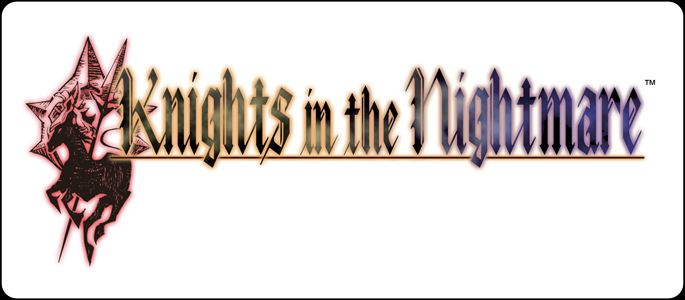Knights in the Nightmare has finally made its way over to the PlayStation Portable. For the uninitiated, the game began life on the Nintendo DS in 2008 in Japan. After a port to North America on the DS and then Japan on the PSP, it is now available for North America on the PSP. Let’s find out how this real-time strategy RPG fared in translation.
The story is much like the rest of the game – very detailed. The storyline is played out in a series of scenes, much like a theatrical play. You play as a Wisp – a soul of an important character in the world. You find yourself suddenly awakened by a mysterious Valkyrie in the middle of a dangerous forest. The world in which this game takes place has some lovely and detailed artwork. A lot of the non-critical characters do have fairly uninspired names, however: Flowered Knight, Tan-Skinned Knight, Tough Knight, Frightened Knight… You get the idea. Their titles describe their personalities. A bit quirky, but since there are so many characters in the many scenes of the story, this aspect of the game is just fine. The plot can be a bit hard to follow if you do not play the game on a regular basis, though. Before all of this, however, you are asked to go through the game’s tutorial – something this reviewer highly recommends due to the complexity of the game. The tutorial is quite in-depth, and can take upwards of an hour if you really read and comprehend every aspect of the game.
Strategy is the name of the game here. Knights in the Nightmare is a grid-based real time strategy RPG, and it is very complex. In fact, explaining everything to you would likely take up this entire review. But the gist of the gameplay is that you set up units on predetermined squares on the map’s grid, which are by default filled in with souls of deceased knights. Before actual combat begins, you can assign up to four weapons or items to use later. Using key items on either knights or NPCs correctly will allow the knight(s) to join your party after a successful battle if they were “guest” souls, or extra items to appear on the battlefield by NPCs. There are seven classes of knights, each with different directions that they can attack. Most units cannot move on the battlefield, with the exceptions being a certain kind of knight and the heroine, who occasionally helps you out in certain key battles. There are also six different elemental types which the knights are associated with, which as expected interact with opponents of other elemental types. Fire is strong when attacking Ice, Ice is strong when attacking Fire, etc… It is basically a more complex form of rock, paper, scissors.

Once you have your units and items ready for battle, you hit start to begin the scene’s fight. This is in real-time, with your character the Wisp controlling your knights. Selecting a knight and holding X initiates them to charge up a regular attack. You aim said attack by moving the Wisp over the grid, preferably at an enemy or an item/obstacle. These attacks do not usually do much damage, but if they successfully hit an enemy various items may fall out. This includes gems, which add to your MP. MP comes into play when using the weapons you equipped earlier in the Tactical Screen before the battle. To get a knight to use the weapon, you move your Wisp over to the corner of the screen where the weapon is, then hold X and drag it to the proper knight. As soon as your Wisp comes in contact with the knight, a Skill Attack begins. Holding this attack until it is fully charged can unleash quite a lot of damage to an enemy.
All of this comes at a price – time. Every round in a battle is 60 seconds. The timer counts down when you are charging up an attack or are hit by an enemy. And it’s not only the knights that can be attacked – your Wisp can and will also be hit by enemy attacks, which are usually shown as neon symbols that float towards your Wisp. This part of the game is not unlike a top-down shooter where you have to avoid touching the enemies. But you have to keep a watchful eye out for attacks at all times, even while charging a knight’s attack. This can make for a hectic battle, and if you time your attacks wrong your Wisp will get hit or you’ll have to move out of the way of an incoming enemy attack. It all makes for a very frenzied battle, and will keep you on your toes (well, if souls have toes, anyway). You have to keep a constant eye on the timer – if it hits zero after your last move and the requisite enemies are not dead, your turn ends. Each level has a certain amount of turns in which you must line up a slot-machine like row of kills.

Yes, that’s right, a slot machine of enemies. After the initial round of enemies are killed off, you are presented with a slot machine-like screen of scrolling enemies, each of which correlate to a position on the Enemy Matrix, which is a 4×4 grid. When that enemy is killed, a KILL logo appears on their position in the matrix. Line up four KILL signs vertically, horizontally, or diagonally to clear the level, unless you are on a boss stage – in which case your only goal is to kill that enemy. It is a unique aspect to the game, though there is no reward for going for a KILL line in one direction over another, only punishment for timing your button presses wrong and stopping one of the reels at the wrong time.
What good is an RPG without customization options? Luckily, Knights in the Nightmare has customizations galore. You can enhance weapons with orbs of the correct type, provided you also have material to complete the enhancement procedure. Each weapon has a durability level, which degrades with each round of battle. The only way to combat this is to fuse two of the same weapons together. This will add the durability values together, however if the weapons are not of the same level then this new forged weapon will take on the level of the weaker of the two. Speaking of forging, you can in a sense also forge two of your party’s knights together. This is called the Transoul. You sacrifice one knight’s soul to be transferred to another, usually with decent or great benefit to the recipient. Just how much it benefits the receiving knight depends on the sacrificial knight’s loyalty to you, as well as their relationship with the recipient. So even party members are capable of being merged.
Knights in the Nightmare obviously has a lot of complexity to it. The game is highly polished, and strategy RPG fans will have a field day with this title. However, those who like their SRPGs as strictly turn-based affairs will likely not enjoy this. But those who like real-time battling and making decisions as the situation changes will love it. The number of things you have to keep in mind can seem daunting at times, but eventually you do get the hang of things. The story can be a bit hard to follow if you don’t play the game on a regular basis, but the core gameplay is solid and consistent throughout the adventure. Knights in the Nightmare is a must-have for strategy RPG fans everywhere.
PlayStation LifeStyle’s Final Score
+ Real-time attack-dodging keeps things exciting. – Lengthy tutorial, may be too complex for some gamers. |
 |
–








